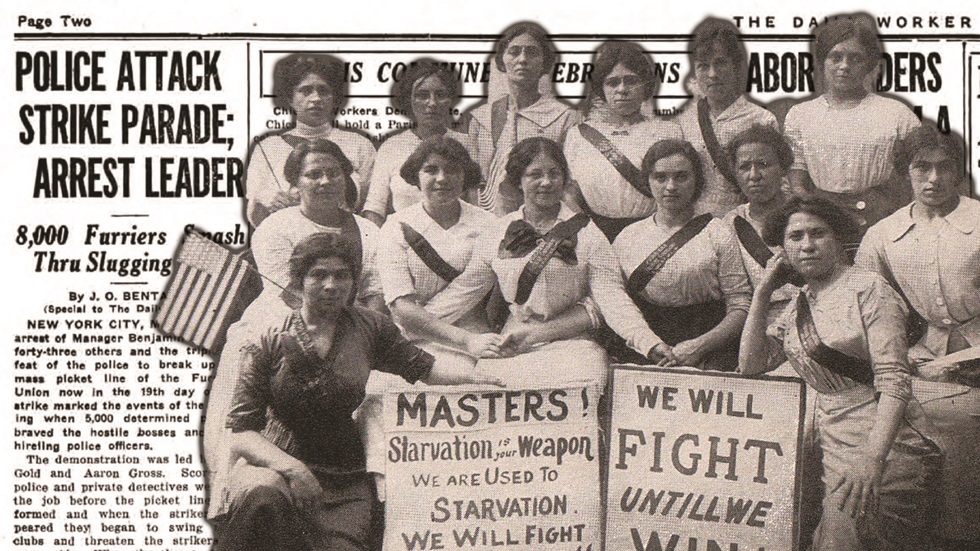
This article is part of the People’s World 100th Anniversary Series.
On Feb. 16, 1926, a massive strike of fur and leather workers in New York—mostly women—began in New York. At the head of the strike was famed Communist Ben Gold, leader of the Fur and Leather Workers Union. After spending weeks on the picket line and withstanding brutal police attacks, the strikers ultimately won a 10% raise—but more importantly for history, they became the first workers to win a 40-hour, five-day work week.
The New York Furriers’ Joint Board contract expired on Jan. 31, 1926. Among the union’s demands were a reduction in working hours to the five-day, 40-hour work week; union inspection of shops; a 25% wage increase; an employer contribution of 3% of each worker’s salary to an unemployment insurance fund; a single paid holiday; and equal division of work among employees to eliminate favoritism.
The employers’ association refused to negotiate over the work week, unemployment fund, or equal division of work, but agreed to seek a settlement on the other terms if the union would withdraw the other three demands.
Exploiting internal union disputes between Socialists and Communists, the employers instituted a lockout of 8,500 workers on Feb. 11, to which the union responded by calling a general strike of all 12,000 fur workers in the city on Feb. 16.
The strike quickly turned violent. On Feb. 19, New York City police attacked a picket line of striking workers and arrested 200. On March 8, Gold called out 10,000 workers for mass picketing throughout the furriers’ district. Police used clubs to beat hundreds of strikers, and then drove cars at high speed into the crowd to try to break up the pickets.
Only when Gold ordered the picket to break up were law enforcement authorities able to regain control. The police response was so brutal that a city magistrate later excoriated the police department for “undue coercion” against the striking workers.
On March 13, a New York state judge refused to grant the employers an injunction which would force an end to the strike. In mid-April, the Eitingon-Schild Company, the wealthiest fur importer in the United States—most of their furs came from the new Soviet Union—broke with the employers’ association to settle with the union.
The company agreed to a five-day, 40-hour work week; equal division of work; no subcontracting; and a 10% wage increase.
But the strike continued despite this agreement. In early April, AFL organizer Hugh Frayne met with a moderate faction within the Joint Board, who asked AFL President William Green to personally intervene in the strike. But when their proposal for a 42-hour work week and a 10% wage increase was presented to the membership on April 15, they overwhelmingly rejected it.
The AFL barred Ben Gold from the meeting, but the membership chanted his name and nearly rioted until he was admitted to the hall. In part, the workers rejected the proposal because they had had no hand in making it. But they also rejected the proposal because it did nothing to help Jewish workers, who needed the five-day work week provision in order to protect their Saturday Sabbath.
In retaliation for the moderates’ attempt to end-run the local leadership, and to increase pressure on the employers, Gold asked the Joint Board to initiate a drive for the 40-hour work week which would involve every union in the city. The Board agreed, and soon the New York State Federation of Labor, the Amalgamated Clothing Workers of America, the Teachers Union, the International Ladies’ Garment Workers’ Union, and a number of other unions agreed to join the effort.
On May 22, 1926, a mass rally filled the newly built Madison Square Garden, making it the largest labor meeting held in the city up to that time. Gold denounced labor leaders who did not attend and declared that winning the 40-hour work week in New York City would lead to a nationwide movement which would gain traction throughout the nation.
The drive for the 40-hour work week pushed the employers to agree to a new collective bargaining agreement. A new contract was reached on June 11, 1926, providing for the 40-hour, five-day work week; an end to overtime from December through August; time-and-a-half overtime pay for half-days from September to November; a 10% wage increase; 10 paid holidays; and a ban on subcontracting.
It was a massive victory for not just the fur and leather workers but for the entire U.S. working class. The bosses wouldn’t forget about the role that the Communists and Ben Gold, in particular, played in the 1926 strike. He remained a target for years, ultimately being tried under the anti-communist provisions of the Taft-Hartley Act in 1950 and sentenced to prison. Gold appealed to the Supreme Court and got his conviction overturned.
The workers also never forgot Gold; in 1954, he was re-elected president of the International Fur and Leather Workers Union, shortly before the creation of the AFL-CIO. Gold remained a Communist—and occasional writer for People’s World—until his death in 1985.
The article below, reprinted from the March 11, 1926, issue of the Daily Worker, details the kind of violence and harassment that fur and leather workers faced at the hands of police during their heroic and historic strike.
Police attack strike parade; arrest leader
8,000 Furriers Smash Thru Slugging Crew
By J.O. Bentall
Daily Worker, March 11, 1926
NEW YORK—The arrest of Manager Benjamin Gold and 43 others and the triple defeat of the police to break up the mass picket line of the Furriers’ Union now in the 19th day of the strlke marked the events of the morning when 5,000 determined pickets braved the hostile bosses and their hireling polite officers.
The demonstration was led by Ben Gold and Aaron Gross. Scores of police and private detectives were on the job before the picket line was formed, and when the strikers appeared, they began to swing their clubs and threaten the strikers on every side. When the threats failed, they bit the strikers on the bead and knocked down scores of them, arresting Manager Gold, hoping in this way to weaken the mass and induce the pickets to disperse.
When they failed in this, they arrested 43 more of the pickets. But even this did not deter the strikers from the task they had set out to accomplish.
The workers ware then driven into a corner near 26th Street, where they were further clubbed. At this place, 12 women were arrested, and the rest told to get away and quit their demonstration.
But instead of the line becoming smaller, it grew until the streets were packed with more union men and women. Many sympathizers joined the demonstration. This was the signal for further brutal attacks by the police. More fiercely than ever the police now plunged into the mass of workers and beat down scores of pickets. But the line broke through the police gang and marched through the fur district, as had been planned from the beginning.
The arrest of Gold the police thought would leave the line leaderless, and the police hoped this would throw the pickets into a panic. Not a single moment was lost because of his arrest. The line forged ahead and made the job a complete success.
When the force sent to stop the strikers failed, cops in Fords came to reinforce them. They came with breakneck speed and ran their Fords upon the sidewalks and directly at large numbers of people on the sidewalk.
The strikers did not budge. The line grew with every new attack and with every brutal assault of the motor oops. Finally, the “law and order” gang were left powerless, and the great mass of pickets, now over 8,000, passed on their way back, und when the line came in front of the Freiheit (newspaper office), it stopped to cheer the paper that has helped so much to inform the Fur Workers about the conditions and helped to hold them firm in this struggle.
In court before Judge Harry Goodman, 26 men and 6 women were lined $5 each, and one was given a suspended sentence. The judge lectured the strikers and told them that no rioting would be tolerated. But the attorney for the pickets declared it was the police that had rioted and not the striking fur workers.
We hope you appreciated this article. At People’s World, we believe news and information should be free and accessible to all, but we need your help. Our journalism is free of corporate influence and paywalls because we are totally reader-supported. Only you, our readers and supporters, make this possible. If you enjoy reading People’s World and the stories we bring you, please support our work by donating or becoming a monthly sustainer today. Thank you!











